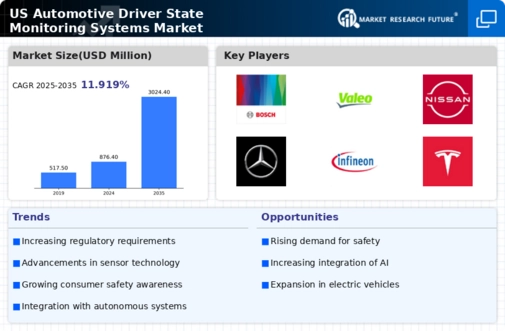Rising Incidence of Driver Fatigue
The increasing incidence of driver fatigue is a critical driver for the automotive driver-state-monitoring-systems market. Studies indicate that drowsy driving contributes to approximately 20% of all motor vehicle accidents in the US. This alarming statistic underscores the necessity for advanced monitoring systems that can detect signs of fatigue and alert drivers. As awareness of the dangers associated with fatigue grows, automotive manufacturers are likely to invest in driver-state-monitoring technologies. The market is projected to expand as these systems become integral to vehicle safety features, potentially leading to a reduction in accidents and insurance costs. Furthermore, the automotive driver-state-monitoring-systems market is projected to see a compound annual growth rate (CAGR) of around 15% over the next five years., driven by the need for enhanced safety measures.
Integration of Artificial Intelligence
The integration of artificial intelligence (AI) into automotive driver-state-monitoring-systems is transforming the market landscape. AI technologies enable real-time analysis of driver behavior, allowing for more accurate assessments of alertness and attentiveness. This capability is particularly relevant as the automotive industry shifts towards autonomous driving solutions. AI-driven systems can learn from individual driver patterns, enhancing their effectiveness over time. The automotive driver-state-monitoring-systems market is likely to benefit from this trend, as manufacturers seek to incorporate AI to improve safety and user experience. The potential for AI to reduce accidents and enhance vehicle performance could lead to a market valuation exceeding $5 billion by 2030, reflecting the growing importance of intelligent monitoring solutions.
Growing Awareness of Distracted Driving
The growing awareness of distracted driving is a pivotal driver for the automotive driver-state-monitoring-systems market. With the proliferation of mobile devices, distractions have become a leading cause of accidents. Educational campaigns and advocacy for safer driving practices are raising public consciousness about the risks associated with distracted driving. Consequently, there is a rising demand for systems that can monitor driver attention and provide alerts when distractions are detected. This trend is likely to propel the automotive driver-state-monitoring-systems market forward, as manufacturers respond to consumer demand for enhanced safety features. Market analysts predict a growth trajectory that could see the market reach $4 billion by 2028, driven by the need for effective solutions to combat distracted driving.
Increased Focus on Vehicle Safety Standards
The heightened focus on vehicle safety standards is a significant driver for the automotive driver-state-monitoring-systems market. Regulatory bodies in the US are increasingly mandating advanced safety features in new vehicles, including driver monitoring systems. This regulatory push is likely to compel manufacturers to adopt these technologies to comply with safety regulations. As a result, the automotive driver-state-monitoring-systems market is expected to witness substantial growth, with projections indicating a market size of approximately $3 billion by 2027. The emphasis on safety not only enhances consumer confidence but also encourages manufacturers to innovate and improve their offerings, thereby driving competition within the market.
Technological Convergence in Automotive Systems
The technological convergence in automotive systems is emerging as a key driver for the automotive driver-state-monitoring-systems market. As vehicles become increasingly interconnected, the integration of various technologies, such as telematics and driver assistance systems, is facilitating the development of comprehensive monitoring solutions. This convergence allows for a holistic approach to driver safety, combining data from multiple sources to enhance the accuracy of monitoring systems. The automotive driver-state-monitoring-systems market is likely to experience growth as manufacturers leverage these synergies to create more sophisticated products. Projections suggest that the market could expand at a CAGR of 12% over the next several years, reflecting the potential for innovation in driver monitoring technologies.
























Leave a Comment